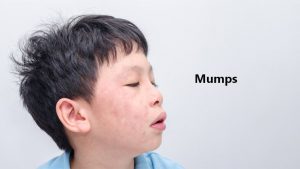
Nội dung bài viết / Table of Contents
This post is also available in: Tiếng Việt (Vietnamese)

Mumps is a contagious disease caused by a virus that passes from one person to another through saliva, nasal secretions, and close personal contact. The condition primarily affects the parotid glands. Parotid glands, also called salivary glands, are the organs responsible for producing saliva.
There are three sets of salivary glands on each side of your face, located behind and below your ears. The hallmark symptom of mumps is swelling of the salivary glands. Symptoms in adults are often more severe than in children. About a third of people have mild or no symptoms.
Complications may include infections of the covering of the brain (15 percent), pancreatitis (four percent), permanent deafness, and painful testicular swelling which uncommonly results in infertility. Women may develop ovarian swelling but this does not increase the risk of infertility.
Without immunization about 0.1 percent to one percent of the population are affected per year. Widespread vaccination has resulted in a more than 90 percent decline in rates of disease. Mumps is more common in the developing world where vaccination is less common.
However, it can be managed by reducing your risk factors. Please discuss with your doctor for further information.
Symptoms of mumps usually manifest within two weeks of exposure to the virus. Flu-like symptoms may be the first to appear, including:
A high fever and swelling of the salivary glands follow over the next few days also noticeable. The glands may not all swell at once. More commonly, they swell and become painful periodically. You are most likely to pass the mumps virus to another person from the time you come into contact with the virus to when your parotid glands swell.
Most people who contract mumps show symptoms of the virus. However, some people have no or very few symptoms.
If you have any signs or symptoms listed above or have any questions, please consulting with your doctor. Everyone’s body acts differently. It is always best to discuss with your doctor what is best for your situation.
The mumps virus is an enveloped single-stranded, linear negative-sense RNA virus of the Rubulavirus genus and Paramyxovirus family. The genome consists of 15,384 bases encoding nine proteins. Proteins involved in viral replication are the nucleoprotein, phosphoprotein, and polymerase protein while the genomic RNA forms the ribonucleocapsid. Humans are the only natural host for the virus. Mumps is spread from person to person through contact with respiratory secretions, such as saliva from an infected person. When an infected person coughs or sneezes, the droplets aerosolize and can enter the eyes, nose, or mouth of another person. Mumps can also be spread by sharing eating utensils or cups. The virus can also survive on surfaces and then be spread after contact in a similar manner. A person infected with mumps is contagious from approximately seven days before the onset of symptoms until about eight days after symptoms start.
Please consult with your doctor for medical advice.
The information provided is not a substitute for any medical advice. ALWAYS consult with your doctor for more information.
During an outbreak, a diagnosis can be made by determining recent exposure and parotitis. However, when the disease incidence is low, other infectious causes of parotitis should be considered such as HIV, coxsackievirus, and influenza. Some viruses such as enteroviruses may cause aseptic meningitis that is very clinically similar to mumps.
A physical examination confirms the presence of the swollen glands. Usually, the disease is diagnosed on clinical grounds, and no confirmatory laboratory testing is needed.
If there is uncertainty about the diagnosis, a test of saliva or blood may be carried out; a newer diagnostic confirmation, using real-time nested polymerase chain reaction (PCR) technology, has also been developed. As with any inflammation of the salivary glands, the serum level of the enzyme amylase is often elevated.
Because mumps is a virus, it doesn’t respond to antibiotics or other medications. However, you can treat the symptoms to make yourself more comfortable while you’re sick.
Read more post:
What are some lifestyle changes or home remedies that can help me manage mumps?
Vaccination can prevent mumps. Most infants and children receive a vaccine for measles, mumps, and rubella (MMR) at the same time. The first MMR shot is generally given between the ages of 12 and 15 months at a routine well-child visit. A second vaccination is necessary for school-aged children between 4 and 6 years old.
Adults who were born before 1957 and haven’t yet contracted mumps may wish to be vaccinated. Those who work in a high-risk environment, such as a hospital or school, should always be vaccinated against mumps.
However, patients who have a compromised immune system, who are allergic to gelatin or neomycin, or who are pregnant, shouldn’t receive the MMR vaccine. If you have any questions, please consult with your doctor to better understand the best solution for you.
Sources: